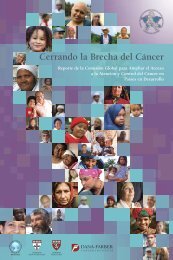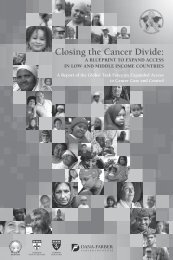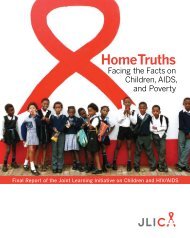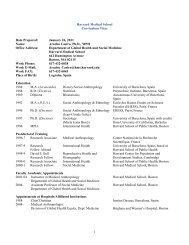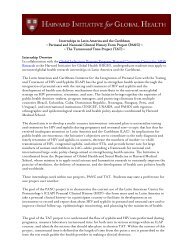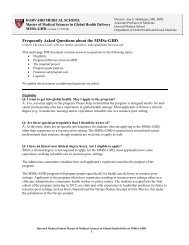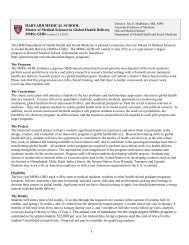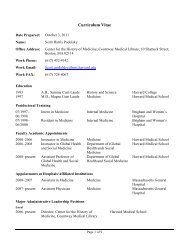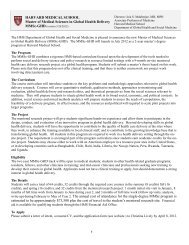Haiti Case Study - The Department of Global Health and Social ...
Haiti Case Study - The Department of Global Health and Social ...
Haiti Case Study - The Department of Global Health and Social ...
You also want an ePaper? Increase the reach of your titles
YUMPU automatically turns print PDFs into web optimized ePapers that Google loves.
law 11 . In 2006, Rene Préval again was elected president <strong>and</strong> remained so until 2011.<br />
President Préval is the first <strong>Haiti</strong>an president to be democratically elected to a second term.<br />
24. Though elected more than once, President Aristide’s rule was marred with political<br />
challenge which has created barriers for <strong>Haiti</strong>’s foreign investment <strong>and</strong> development.<br />
Concern over corruption <strong>and</strong> Aristide’s leftist policies led the donor community, <strong>and</strong> the US in<br />
particular, to refuse money to his government <strong>and</strong> funnel it instead to largely foreign based<br />
NGOs 12 .<br />
25. This lack <strong>of</strong> stable, credible governance <strong>and</strong> finance, as well as a lack <strong>of</strong> trust between<br />
<strong>Haiti</strong>an leadership <strong>and</strong> powers beyond its borders, led to the government’s inability to<br />
perform basic functions, like issuing birth <strong>and</strong> death certificates <strong>and</strong> l<strong>and</strong> deeds, regulating<br />
industry <strong>and</strong> providing <strong>and</strong> enforcing building codes, much less providing health <strong>and</strong><br />
education services 13 . In addition, environmental vulnerabilities went unaddressed, most<br />
notably deforestation for the purposes <strong>of</strong> charcoal production, which is <strong>Haiti</strong>ans main source<br />
<strong>of</strong> fuel. Only an estimated 2% <strong>of</strong> <strong>Haiti</strong>’s forests remain <strong>and</strong> this has led to a fragile<br />
environment with l<strong>and</strong>slides <strong>and</strong> devastating floods wracking <strong>Haiti</strong>’s hurricane vulnerable <strong>and</strong><br />
erosion prone coastline 14 . In 2001, <strong>Haiti</strong> remained the least water secure nation in the<br />
world 15 . <strong>Haiti</strong> is a fragile state indeed <strong>and</strong> one frequently affected by <strong>and</strong> vulnerable to crisis.<br />
A CRISIS-AFFECTED FRAGILE STATE<br />
26. In July 2010, Active Learning Network for Accountability <strong>and</strong> Performance in<br />
Humanitarian Action (ALNAP), in partnership with the UN Evaluation Group, published a<br />
<strong>Haiti</strong> Context Analysis report whose purpose was to “provide a useful contextual background<br />
for operational reflection [<strong>and</strong> to] serve as a sound <strong>and</strong> shared foundation for evaluative<br />
efforts going forward” 16 . <strong>The</strong> project team found that this report provides a solid summary for<br />
underst<strong>and</strong>ing the historical, political, <strong>and</strong> social context <strong>of</strong> <strong>Haiti</strong> as a fragile state prior to the<br />
earthquake.<br />
27. <strong>The</strong> ALNAP report summarizes <strong>Haiti</strong>’s political <strong>and</strong> social context as follows:<br />
“<strong>Haiti</strong> has endured political instability, chronic challenges in governance <strong>and</strong> the highest<br />
levels <strong>of</strong> poverty in the Western Hemisphere. According to several indexes measuring<br />
states’ fragility, <strong>Haiti</strong> performs particularly poorly ranking twelfth out <strong>of</strong> 177 countries in<br />
the Failed States Index <strong>and</strong> 129th <strong>of</strong> 141 countries according to the Index <strong>of</strong> State<br />
Weakness in the Developing World…”<br />
“<strong>The</strong> rapid urbanisation has a negative impact on the local environment <strong>and</strong> the country’s<br />
natural resources. In 2007 45.6 per cent <strong>of</strong> the population lived in urban centres that have<br />
more than doubled in size since 1982. As a result vulnerable populations live in highdensity<br />
<strong>and</strong> <strong>of</strong>ten appalling living conditions in slums, triggering public health <strong>and</strong> other<br />
problems.”<br />
28. In light <strong>of</strong> this political <strong>and</strong> social context, the ALNAP report concludes that “the country<br />
is highly vulnerable to disasters such as floods, l<strong>and</strong>slides, storms, hurricanes, tsunamis <strong>and</strong><br />
earthquakes. Between 2001 <strong>and</strong> March 2007, disasters resulted in 18,441 deaths, 4,708<br />
injuries <strong>and</strong> 132,000 homeless; some 6.4 million people were affected <strong>and</strong> damage was<br />
estimated at USD4.6 billion”.<br />
THE HEALTH SYSTEM<br />
29. Prior to the earthquake, <strong>Haiti</strong>’s population suffered from some <strong>of</strong> the worst health<br />
outcomes in the Western Hemisphere, worsening with eruptions <strong>of</strong> political strife, divestment<br />
<strong>of</strong> aid to the public sector, embargoes <strong>and</strong> coups. 17 Comparing <strong>Haiti</strong>an health outcomes to<br />
those <strong>of</strong> the Dominican Republic, its only neighbour, is particularly illustrative <strong>of</strong> <strong>Haiti</strong>’s plight.<br />
Life expectancy in <strong>Haiti</strong> is 63 years compared to 72 in the Dominican Republic. 76 children<br />
per 1,000 live births will die before their fifth birthday in <strong>Haiti</strong>, compared with 24 in the<br />
6



